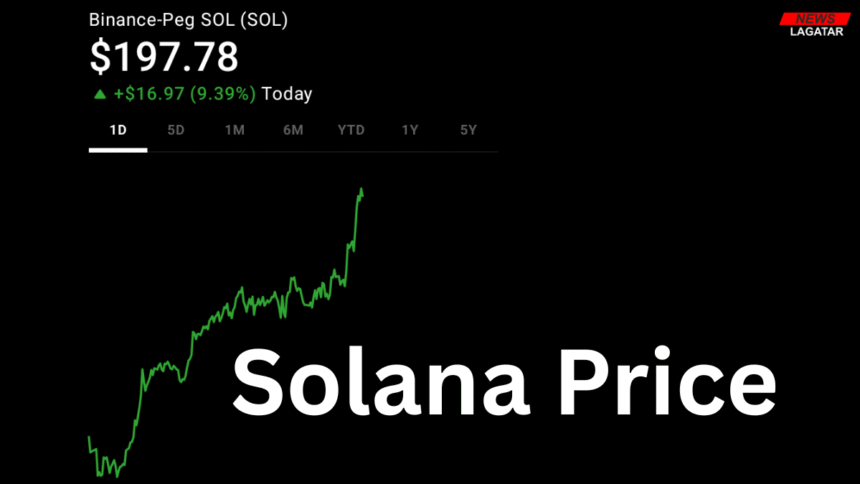What’s Fueling the Rally?
Solana Price (SOL), one of the top-performing altcoins of the last few years, is making headlines again. In July 2025, SOL has shown a strong bullish trend, rising nearly 35% from around $130 to above $190, and is currently trading in the $195–$198 range. Investors, traders, and analysts are watching closely to determine whether this is just a relief rally — or the beginning of another major bull run.
best credit card for beginners USA 2025
📈 What’s Behind Solana’s Latest Price Surge?
Several key factors are driving Solana’s current momentum:
Technical Breakout Patterns: Analysts have identified a “cup-and-handle” chart pattern — often a bullish signal that suggests long-term upside potential. If the pattern plays out fully, some projections see Solana potentially hitting $300–$600 in the next year.
Rising Institutional Interest: According to CoinShares, Solana received $39 million in institutional inflows last week alone, bringing its year-to-date total to $245 million — the most among all altcoins.
On-Chain Metrics: Metrics like Open Interest (OI) and Spent Output Profit Ratio (SOPR) are signaling strong investor confidence and buying pressure. Futures Open Interest for Solana has increased from $7.1 billion to $9.5 billion since the start of July.
💹 Current Price Action and Key Resistance Levels
As of today, July 21, 2025, Solana is hovering just below $200, facing resistance around the $198–$200 level. If SOL breaks above that zone, analysts believe the next stop could be $220, followed by a move toward $300 or higher if volume supports the breakout.
On the flip side, if it fails to break above $200, short-term support levels to watch are $187, $175, and then $166. A drop below $166 may indicate a trend reversal or at least a temporary cooldown.
🧠 Technical Indicators to Watch
RSI (Relative Strength Index): SOL’s RSI is currently above 70, indicating it’s in overbought territory. That usually signals a possible pullback but can also indicate strong bullish momentum.
Volume Trends: Daily trading volume is increasing, a positive sign that the rally may have legs.
Cup-and-Handle Pattern: This textbook pattern historically leads to 60%+ rallies when completed. However, about 39% of these patterns fail, so risk management remains essential.
📊 How Are U.S. Investors Responding?
U.S.-based crypto funds and platforms are reporting increased interest in Solana:
Platforms like Coinbase and Kraken have seen surges in SOL-related activity.
Solana Price staking is also rising on U.S. exchanges, with yields hovering around 6–7% annually.
Retail investors on platforms like Robinhood are returning to altcoins, especially as Bitcoin’s price slows.
For U.S. investors, Solana’s appeal lies in its ultra-fast transaction speeds, low fees, and growing developer ecosystem — especially in NFTs, gaming, and DeFi.
🧾 Regulatory Factors to Consider
The U.S. government recently passed the Genius Act, a law to regulate stablecoins, and the Clarity Act, aimed at giving clearer guidelines for crypto tokens. While Solana is not a stablecoin, these laws indicate a more mature, supportive regulatory environment for legitimate crypto assets. This has encouraged U.S.-based institutional investors to increase exposure to top altcoins like SOL.
🔮 Final Thoughts: What’s Next for Solana Price?
Solana’s current rally is supported by strong technical patterns, growing institutional demand, and favorable on-chain data. However, with resistance around $200 and macro uncertainty still present, it’s important to remain cautious.
If Solana Price breaks above $200 and holds, targets of $220, $250, and eventually $300–$400 are on the table. But if momentum fades, expect a retest of lower support levels before another leg up.
Solana Price (SOL) is trending in July 2025 with a 35% surge, currently near $198. Learn what’s driving the price up, key resistance levels, technical analysis, and whether SOL can break $300. Read the latest expert insights for U.S. investors.For long-term U.S. investors and crypto traders, Solana remains one of the most promising Ethereum alternatives — especially in real-world use cases like NFTs, gaming, and tokenized assets.






